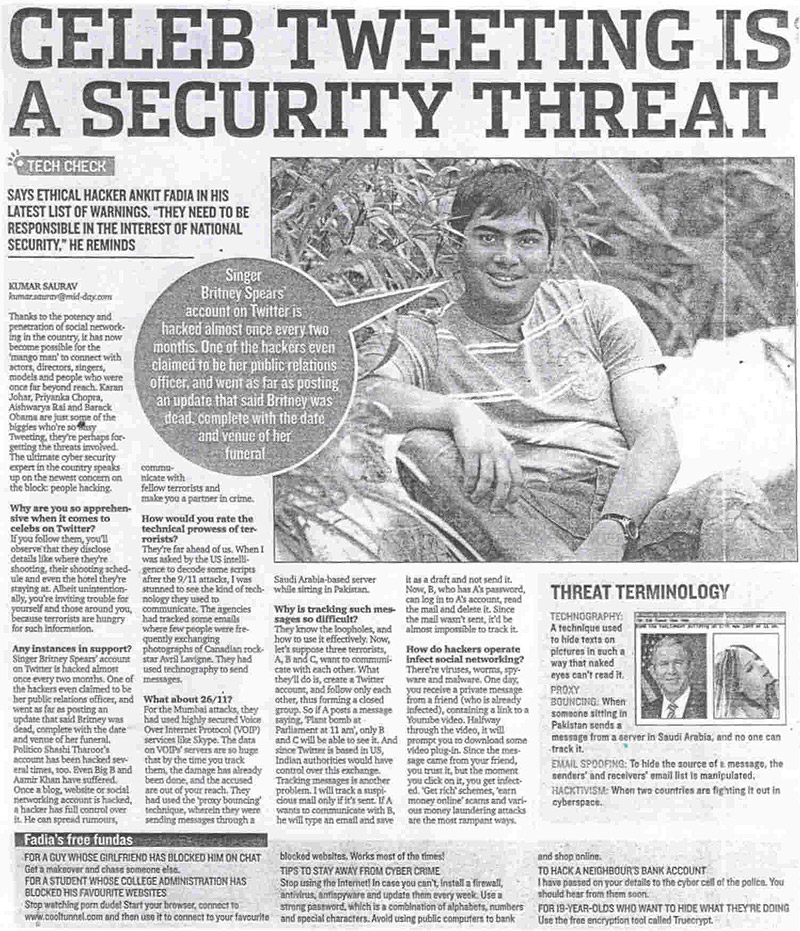Ankit Fadia
Claims of Decrypting Messages from Osama Bin Laden - Debunked
Sat May 12 13:30:01 CDT 2012
For almost a decade, Ankit Fadia has been riding on vague claims that he was called in to help
decrypt messages from Osama Bin Laden (OBL) shortly after 9/11. He was approximately
16 years old at the time and had written at least one
book that was heavily plagiarized. There are two ways to debunk these wild claims.
First, the "sniff test". Would a U.S. intelligence agency that handles decrypting messages
from terrorists really go to a 16 year old Indian boy that had no published cryptography
experience? Would they seek Fadia out when they could seek out
more respected experts
here in the U.S.? If it was the NSA, the leading power in communications interception and
cracking at the time, who's budget
deals in the billions of dollars, would they really seek out a 16 year-old foreign national
with a desktop computer to crack such a message? Absolutely not.
Second, reading Fadia's claims about this and taking note of how the story has changed
is very telling. What was originally a vague one line mention of the supposed decryption
work, has since been expanded. From Fadia's bio we
typically read "In November 2001, Fadia was consulted by a classified intelligence agency for breaking an encrypted message sent by one of Osama Bin Laden's men."
Interestingly enough, Fadia's resume from 2004 alters that to say
"encrypted message (believed to have been) sent by one of Osama Bin Laden's men."
More importantly, in Fadia's revisionist history, he has
now injected details which demonstrate that it is all a fabrication.
| Date |
Quote/Source |
| 2003-01-28 |
"Workers at ground zero had just started carting away the WTC rubble when a top-secret US security agency tracked down Ankit Fadia."
What did they want with this young boy - a New Delhi native? The Federal agents suspected that Osama Bin Laden and his terrorist network were using Steganography to communicate with each other.
They wanted Ankit to decode the subterfuge. "I sent them everything I knew... how Steganography works, how to detect and decrypt hidden data et al," says the internationally acclaimed hacker-cracker."
- Source
|
| 2003-08-05 |
"Fadia says he has worked for a non-Indian intelligence agency, helping to break algorithms used to encrypt data suspected to belong
to a terrorist group. The data was hidden in an image using steganography and encrypted three times using three customised algorithms."
- Source
|
| 2007-12-05 |
Third-party review of Fadia training seminar: After that, he showed steganography, which is basically encrypting images in innocent looking
photos (like that of Avril Lavigne, which he used). Now what he claimed then (and has for quite some time is) that after the 9/11 attacks
in USA "certain undisclosed security agencies in the USA" intercepted messages from Al-Qaeda and sent them to our dear friend because they
couldn't figure out what it was. Our dear friend, as he says, couldn't figure out anything
for 3 weeks, and in the 4th week (yay, Google search!) it struck him that it could be this. Our dashing young frood then told his
masters in the US, and got the license to have his martini shaken AND stirred. I might add here that
the sarcasm + wisecracks here are by me, lest you think he's a (non)sense of humor."
- Source
|
| 2009-11-18 |
How would you rate the technical prowess of terrorists?
"They're far ahead of us. When I was asked by the US intelligence to decode some scripts after the 9/11 attacks, I was stunned to see the kind of
technology they used to communicate. The agencies had tracked some emails where few
people were frequently exchanging photographs of Canadian rockstar Avril Lavigne. They had used technography [sic] to send messages."
- Source
|
| 2009-12-04 |
"Immediately after that 9/11 happened in the US, and the US government got in touch with me via the CBI on steganography, a technology which allows text messages to be hidden in photographs."
- Source
|
Despite claiming to have decrypted messages as far back as 2003 (possibly earlier), certain "details"
did not begin to emerge until 2007. It was only then that we learned that the images
containing stegonography were of Avril Lavigne. Fadia says that
"immediately after that 9/11 happened", he was contacted. The first problem is that
Avril Lavigne's debut album, "Let Go", was released on July 22, 2002,
some 10 months after the 9/11 attacks.
Looking at all of Fadia's claims about his alleged decryption work lets
us consider the question in context:
Are we really to believe the U.S. National Security Agency went to a 16 year-old foreign national in India
with no published research on encryption to enlist his help decrypting stegonography-hidden messages that used three
customized encryption algorithms using just his desktop computer? Absolutely not.

They're far ahead of us. When I was asked by the US intelligence to decode some scripts
after the 9/11 attacks, I was stunned to see the kind of technology they used to communicate.
The agencies had tracked some emails where few people were frequently exchanging photographs
of Canadian rockstar Avril Lavigne. They had used technography [sic] to send messages."



